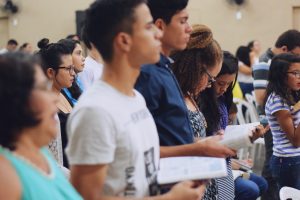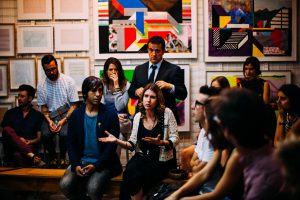In my visit to the Pacific School of Innovation and Inquiry, I was astounded by how much it did not reflect a traditional school. Just the location alone was different. Having a school in the heart of downtown, in what appears to be an office building, sets the stage for a non-traditional learning environment. Beyond this, the lack of classrooms creates a free-flowing school which allows for the lack of structure and schedule that the school establishes. Walking through the school I didn’t feel like I was in a school, but I definitely felt that learning was taking place. All around our class were students and teachers working on their inquiries while sharing ideas and knowledge. I felt the sense of creativity and growth that the founders of the school chose to foster.
In our chat with the Principle, I could sense his passion for the school and its structure. The idea of creating a space that allowed students to have autonomy in their own journey to master the curriculum is something that I really agreed within his talk. I liked that they weave the curriculum into the students’ own paths and not base their paths around the curriculum. Furthermore, I like that they have a tie to the university, allowing students that extend beyond the school’s expertise, to have a place to go.
Overall, the Pacific School of Innovation and Inquiry is something so different from a traditional school environment that it is hard to imagine what it would be like without experiencing it. From what I learned today, I can see the benefits that could exist in this type of schooling. But I can also see how some students would find this set up to be overwhelming and confusing. I know that I would never want to learn in a school like this. I thrive off the structured environment that school offers. I think that it also teaches a lot of important skills needed later in life, such as study skills, close reading and analysis, meeting deadlines, and adaptability. But in saying this, I do value many of the ideas that this school offer. I would just not go to the extreme of a full inquiry-based school.

 The documentary first focuses on the band Girl Talk who challenges copyright laws as he is creating something new using the work of others before him. His manifesto is that “culture always builds on the past”. Where people have trouble with this statement is when they question if his music is truly his or if it is partially the work of others. With the evolution of music and technology, this question becomes more and more complicated.
The documentary first focuses on the band Girl Talk who challenges copyright laws as he is creating something new using the work of others before him. His manifesto is that “culture always builds on the past”. Where people have trouble with this statement is when they question if his music is truly his or if it is partially the work of others. With the evolution of music and technology, this question becomes more and more complicated. ance of copyright laws and music sharing, as well, as the growth of the technology side of the music world.
ance of copyright laws and music sharing, as well, as the growth of the technology side of the music world. this. AKA 2 companies own all of American Media and decide where and to whom it goes.
this. AKA 2 companies own all of American Media and decide where and to whom it goes. Social media is a hot button topic for many. The strong opinions that people tie themselves to makes for heated arguments that are one sided with no middle ground. Social media’s popularity in today’s culture makes it hard to avoid and impossible to escape. With the ever changing definition of what social media is and what its main purpose is, people are left to drifting with the tides of trend, rip curled into the sea of endless screen time.
Social media is a hot button topic for many. The strong opinions that people tie themselves to makes for heated arguments that are one sided with no middle ground. Social media’s popularity in today’s culture makes it hard to avoid and impossible to escape. With the ever changing definition of what social media is and what its main purpose is, people are left to drifting with the tides of trend, rip curled into the sea of endless screen time. seemed to be made on snap, on the memories that are kept on Instagram. But I also feel like I was saved from constant comparison, the feeling of missing out, on the stress of replying to everyone, the pressure of creating a cohesive feed. Overall I don’t regret my decision, but there are times that I wonder where I would be if I had let the world influence me at a time that I didn’t even know myself.
seemed to be made on snap, on the memories that are kept on Instagram. But I also feel like I was saved from constant comparison, the feeling of missing out, on the stress of replying to everyone, the pressure of creating a cohesive feed. Overall I don’t regret my decision, but there are times that I wonder where I would be if I had let the world influence me at a time that I didn’t even know myself. With everything stated above, I want to dive into how social media has affected our society. its youth, its body image, its communication sources, its effect on the climate. EVERYTHING. I want to know what this thing on my phone is really doing to me without my knowledge. Is it really good for me or is society and social pressure telling me that. Writing that list above makes me embarrassed and intrigued to see where this journey takes me. Its going to be a very interesting journey where I need to be honest with myself more than i would like to be, but I’m excited to see where it goes.
With everything stated above, I want to dive into how social media has affected our society. its youth, its body image, its communication sources, its effect on the climate. EVERYTHING. I want to know what this thing on my phone is really doing to me without my knowledge. Is it really good for me or is society and social pressure telling me that. Writing that list above makes me embarrassed and intrigued to see where this journey takes me. Its going to be a very interesting journey where I need to be honest with myself more than i would like to be, but I’m excited to see where it goes. s perspective, having no guidelines can be a place for creativity and your own exploration. It allows for you to teach a topic that you are passionate about, creating a class environment that is vivacious and spilling over with creativity. On the other side of the coin, this freedom can allow students to fall through the gaps. There can be a gap in curriculum, but there can also be a lack of interest in the teacher’s chosen topic. This can create a problem as the educator to get all students engaged on the very niche topic chosen.
s perspective, having no guidelines can be a place for creativity and your own exploration. It allows for you to teach a topic that you are passionate about, creating a class environment that is vivacious and spilling over with creativity. On the other side of the coin, this freedom can allow students to fall through the gaps. There can be a gap in curriculum, but there can also be a lack of interest in the teacher’s chosen topic. This can create a problem as the educator to get all students engaged on the very niche topic chosen.
